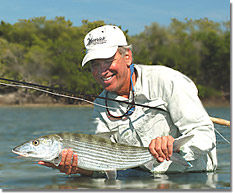
Bonefish are predators, but their life is still one of eat or be eaten. If you have ever seen a bonefish do battle with a crab you will be convinced of its determination to eat. Watch a bonefish become alarmed and it is astounding how quickly it will abandon that meal when it senses a threat. A bonefish has a radar array that is controlled primarily by its lateral line. It senses both good and bad vibrations. A shark entering the flat 100 yards away can put down an entire school of bonefish. A crab shuffling its fins into the marl produces a sound that rings like a dinner bell. An angler can see the excitement in the bone by the way its dorsal fin quivers. Often, in this state of tunnel vision, a bonefish can be excited to the point of distraction. A wise angler chooses this moment to make the shot.
Make a bonefish eat (even if it really doesn't want to)
You have psyched yourself up to the challenge of bonefishing. You have discovered where they live and how to make a quiet approach. You have the right fly rod in your hand and your cast is on target. Now what? Capitalize on everything you have learned about bonefish. Appeal to their competitive nature. Target the most aggressive fish. Just getting the fly in the right place is not good enough. Make it look like food. A clump of marabou can give a better perception of being a shrimp than the real thing if the angler properly works the fly. Remember that these fish eat as predators and flee as prey. Stripping the fly so that a passive bonefish first notices, then follows, chases, and finally pins it to the bottom before claiming its prize, is an accomplishment that lets you remember why you are fishing instead of instead of playing golf.
Presentation, Presentation, Presentation
There is no such thing as a lucky bonefisherman. If you can deliver the food to the table, you are (usually) rewarded with a bite. Taking too many false casts to load the rod, leaving the cast five feet short of the fish, casting a heavy loop that lands fat, are all techniques certain not to catch bonefish. Think of the fly rod as a conductor's baton. Establish a rhythm that matches the pace of the bonefish. If a fish is moving off a flat, it is still possible to get a grab, but the delivery must be forceful and without delay. If the bonefish is noodling around in six inches of glassy calm water, your cast had better float down like a feather or that fish will be walking on water as it blows the flat. Choose your fly rod more carefully than any other decision you make when you are fishing for bonefish. If the cast is not there, you are going back to the dock empty handed.
All Bonefish Are Not Created Equal
Do not let anybody tell you that bonefish, even small ones out of vast schools, are carbon copies of one another. Each fish is as different as a snowflake. They feed differently, fight differently, and to an observant eye, they appear different. Anglers who understand this catch more fish. Bonefish-savvy anglers know when to upsize or downsize tackle. Fly selection is as critical as it is to trout eating emergers. The true challenge of this great fish is its unpredictability. Bonefish are ultra-competitive when they feed. Being able to identify the alpha bone in a pack of tailing fish brings an angler to a higher level of the game.
A bonefish in hand is worth a hundred on the flat
You have heard the anglers who come in from bonefishing and they say, "Gosh what a wonderful day. You know, just seeing all those bonefish was great!" Hogwash. If you want to see bonefish go to the New England Aquarium. If you want to catch bonefish, remember that if you pay your dues, you catch your fish. Paying your dues means being prepared mentally-this is a chess match and the fish usually win. You must be prepared physically-stalking bonefish all day under a tropical sun is difficult if you are hung over or out-of-shape. Moreover, the angler must come equipped with the right tools for the job. A soft action fly rod will not be effective casting in conditions that include wind and moving targets. The Helios 908-4 Tip Flex is my idea of a perfect bonefish rod. It is balanced, accurate, and has all the juice necessary for bonefish. Your click-and-pawl salmon reel will not stop these fish. I use a Battenkill Large Arbor Big Game because it is a lightweight reel with a fast retrieve and a drag to stop a hard-charging bonefish. Borrowed flies that work great in Belize are not going to catch bonefish in the Florida Keys. My fly box for the Keys includes the Meko Special, Foxy Bonefish Clousers, and my all-time favorite, Whisper Crab. Turning over these heavy flies is critical, so use Mirage leaders and tippet material. It is strong, abrasion- resistant, and invisible. Stack the cards in your favor. We are blessed to be in the presence of bonefish but be well advised not to underestimate them.
Jeffrey Cardenas guided anglers to bonefish in the Florida Keys for more than two decades. He is the owner of The Saltwater Angler, an Orvis Endorsed Outfitter in Key West, and Contributing Editor for Fly Rod & Reel magazine. Signed First Editions of his new book, Sea Level are available by calling (800) 223-1629.




